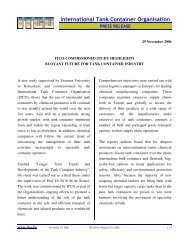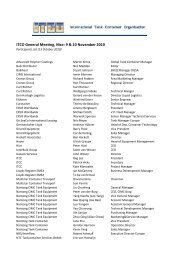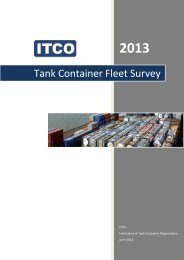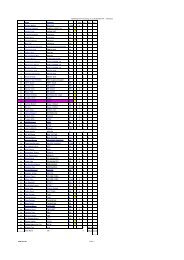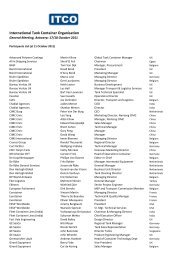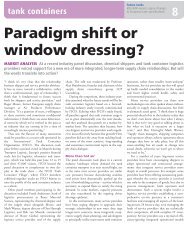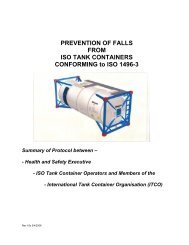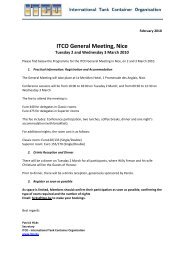You also want an ePaper? Increase the reach of your titles
YUMPU automatically turns print PDFs into web optimized ePapers that Google loves.
ICHCA International <strong>Safe</strong>ty Panel Briefing Pamphlet No 30<br />
Annex 2 Centre <strong>of</strong> Gravity, Ullage and Degree <strong>of</strong> Filling<br />
A2.1 Centre <strong>of</strong> Gravity<br />
A2.1.1 Different types <strong>of</strong> tank may have a different centre <strong>of</strong> gravity, dependent on<br />
the design and the amount <strong>of</strong> steel in the framework.<br />
A2.1.2 Typically an empty tank will have a lower centre <strong>of</strong> gravity than will a loaded<br />
tank. However a loaded tank will have a dynamic centre <strong>of</strong> gravity that shifts<br />
marginally longitudinally and laterally and upwards as the contents surge<br />
fore or aft or from side to side. When the tank is correctly filled this should<br />
not affect stability (see section A2.4 Free Surface Effect).<br />
A2.1.3 When handling tank containers, operators should be aware that on vehicles,<br />
including handling equipment, where a dynamic centre <strong>of</strong> gravity may affect<br />
the stability <strong>of</strong> the vehicle, the loaded tank container should be transported<br />
so that the combined centre <strong>of</strong> gravity (vehicle and tank container) is as low<br />
as practicable.<br />
A2.2 Degree <strong>of</strong> Filling<br />
A2.2.1 Prior to filling, the shipper shall ensure that the appropriate tank container is<br />
used and that the tank container is not loaded with cargo that, in contact with<br />
materials <strong>of</strong> the shell, gaskets, service equipment and any protective linings,<br />
is likely to react dangerously with them to form dangerous products or<br />
appreciably weaken the materials.<br />
A2.2.2 Portable tanks shall not be filled in excess <strong>of</strong> the maximum degree <strong>of</strong> filling<br />
specified in A2.2.3 to A2.2.8. The applicability <strong>of</strong> A2.2.3, A2.2.4 or A2.2.8 to<br />
individual substances is specified in the applicable portable tank instructions<br />
(see 0 section A5.1.3).<br />
A2.2.3 The maximum degree <strong>of</strong> filling (in %) for general use is determined by the<br />
formula:<br />
Degree <strong>of</strong> filling =<br />
A2.2.4 The maximum degree <strong>of</strong> filling (in %) for liquids <strong>of</strong> class 6.1 and class 8, in<br />
packing groups I and II, and liquids with an absolute vapour pressure <strong>of</strong><br />
more than 175 kPa (1.75 bar) at 65 ° C, or for liquids identified as marine<br />
pollutants is determined by the formula:<br />
Degree <strong>of</strong> filling =<br />
97<br />
1 + α(tr - tf)<br />
95<br />
1 + α(tr - tf)<br />
Page 47 ©ICHCA International Limited



